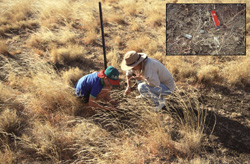Elliot's discovery

The remains of Elliot the sauropod, Australia's largest dinosaur, were discovered in 1999 by his namesake Dave Elliott on a property near the outback town of Winton, central-western Queensland. Dave was mustering sheep on his motorbike at the time and almost rode over part of the 1.6-metre long thighbone. Along with his wife Judy and four children, Dave returned to the site several times the following year, collecting portions of vertebrae, ribs and hundreds of small fragments.
In 2001, Dr Mary Wade, former Curator of Palaeontology at the Queensland Museum, saw the bones that Dave had collected, and recognised them as belonging to a sauropod. But it was not until July 2001, when Dr Steve Salisbury and a team from the Queensland Museum visited Dave and his family, that the full significance of the find was realised: the bones Dave had stumbled upon belonged to the largest dinosaur yet found on Australian soil.
Dave invited the team back to his property in September 2001. Based on previous sauropod finds in the Winton area over the last 30 years, it was assumed that the bones that Dave had found on the surface of the soil had derived from a layer of rock that had since weathered away. But careful examination of the site revealed that this was not the case at all.

Throughout large parts of western Queensland the upper units of the Winton Formation have broken down to form a thin veneer of clay soil, commonly known as ?blacksoil'. Exploratory digging at the Elliot site revealed that the bones that Dave had been found on the surface actually derived from a layer of siltstone just beneath the base of the blacksoil. Where this fossil-bearing horizon contacts the soil, the bones appear to have been transported to the surface through opening and closing of deep fissures and cracks in response to irregular periods of wet and dry. This suggested that more of Elliot's remains were still trapped beneath the surface, and plans were made for a full-scale excavation in 2002. So commenced one of the largest excavations of a single dinosaur skeleton ? or so it was assumed ? ever undertaken in Australia.
